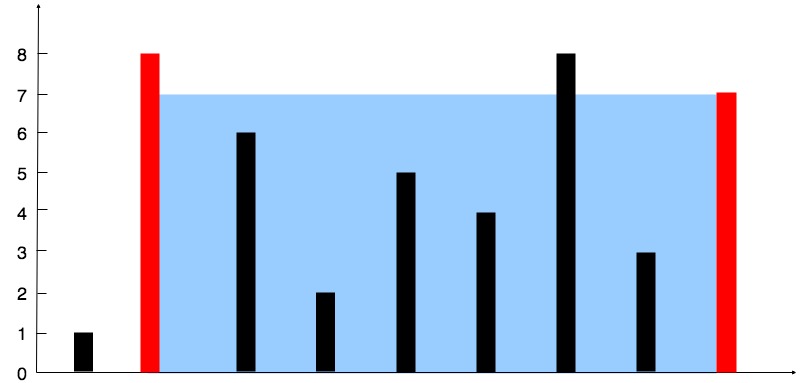You are given n non-negative integers a1, a2, ..., an , where each represents a point at coordinate (i, ai). n vertical lines are drawn such that the two endpoints of line i are (i, ai) and (i, 0). Find two lines, which together with the x-axis form a container, such that this container contains the most water.
Note: You may not slant the container and n is at least 2.

The above vertical lines are represented by the array [1,8,6,2,5,4,8,3,7]. In this case, the max area of water (blue section) one container can contain is 49.
Example:
Input: [1,8,6,2,5,4,8,3,7] Output: 49
The core challenge of this problem is to find two lines that, together with the x-axis, form a container that can hold the maximum amount of water. The height of the water is determined by the shorter of the two lines, and the width is the distance between the two lines.
This problem is significant in various applications, such as optimizing storage in containers, designing efficient water reservoirs, and more.
Potential pitfalls include misunderstanding the problem constraints, such as assuming the lines can be slanted or not considering the width between the lines.
To solve this problem, we can start with a naive approach and then move to more optimized solutions.
The naive approach involves checking all possible pairs of lines and calculating the area for each pair. This approach has a time complexity of O(n^2), which is not efficient for large inputs.
A more efficient approach is to use the two-pointer technique. We start with two pointers, one at the beginning and one at the end of the array. We calculate the area formed by the lines at these two pointers and then move the pointer pointing to the shorter line inward. This process is repeated until the two pointers meet.
This approach works because moving the pointer pointing to the shorter line has the potential to find a taller line, which could increase the area. The time complexity of this approach is O(n).
Here is a step-by-step breakdown of the two-pointer algorithm:
public class ContainerWithMostWater {
public int maxArea(int[] height) {
// Initialize two pointers
int left = 0;
int right = height.length - 1;
// Variable to store the maximum area
int maxArea = 0;
// Loop until the two pointers meet
while (left < right) {
// Calculate the area
int width = right - left;
int currentHeight = Math.min(height[left], height[right]);
int currentArea = width * currentHeight;
// Update maxArea if the current area is greater
maxArea = Math.max(maxArea, currentArea);
// Move the pointer pointing to the shorter line inward
if (height[left] < height[right]) {
left++;
} else {
right--;
}
}
// Return the maximum area found
return maxArea;
}
public static void main(String[] args) {
ContainerWithMostWater solution = new ContainerWithMostWater();
int[] height = {1, 8, 6, 2, 5, 4, 8, 3, 7};
System.out.println("Max Area: " + solution.maxArea(height)); // Output: 49
}
}
The time complexity of the two-pointer approach is O(n) because we only traverse the array once. The space complexity is O(1) as we are using a constant amount of extra space.
Potential edge cases include:
To test these edge cases, we can use the following examples:
int[] height1 = {1, 1};
int[] height2 = {5, 5, 5, 5, 5};
To test the solution comprehensively, we should include a variety of test cases, from simple to complex. Here are some examples:
public static void main(String[] args) {
ContainerWithMostWater solution = new ContainerWithMostWater();
// Test case 1: Example case
int[] height1 = {1, 8, 6, 2, 5, 4, 8, 3, 7};
System.out.println("Max Area: " + solution.maxArea(height1)); // Output: 49
// Test case 2: Only two elements
int[] height2 = {1, 1};
System.out.println("Max Area: " + solution.maxArea(height2)); // Output: 1
// Test case 3: All elements the same
int[] height3 = {5, 5, 5, 5, 5};
System.out.println("Max Area: " + solution.maxArea(height3)); // Output: 20
// Test case 4: Increasing heights
int[] height4 = {1, 2, 3, 4, 5};
System.out.println("Max Area: " + solution.maxArea(height4)); // Output: 6
// Test case 5: Decreasing heights
int[] height5 = {5, 4, 3, 2, 1};
System.out.println("Max Area: " + solution.maxArea(height5)); // Output: 6
}
When approaching such problems, it is essential to:
In this blog post, we discussed the "Container with Most Water" problem, explored different approaches to solve it, and provided a detailed explanation of the optimized two-pointer technique. We also analyzed the complexity, discussed edge cases, and provided comprehensive testing examples.
Understanding and solving such problems is crucial for developing strong problem-solving skills and preparing for technical interviews. Keep practicing and exploring further to improve your skills.
For further reading and practice problems related to this topic, consider the following resources:
Our interactive tutorials and AI-assisted learning will help you master problem-solving skills and teach you the algorithms to know for coding interviews.
Start Coding for FREE